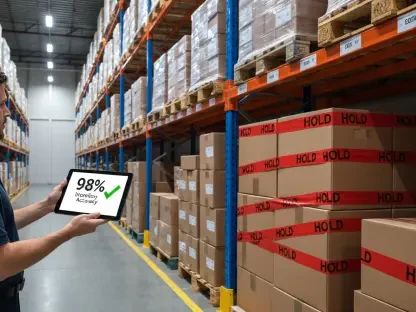What happens when a single misplaced shipment in Shanghai delays a customer order in Seattle, costing thousands in penalties and trust? In the high-stakes arena of global logistics, where every second counts across sprawling supply chains, the right technology can mean the difference between seamless success and catastrophic failure. This feature dives into the transformative power of a custom Warehouse Management System (WMS), revealing how tailored solutions are redefining efficiency for businesses navigating international fulfillment.
The Stakes of Global Logistics—Why Systems Matter
The complexity of managing warehouses across continents is staggering—think transit hubs in Asia, long-term storage in Europe, and e-commerce fulfillment centers in North America, all needing to sync in real time. A staggering 68% of logistics leaders report that outdated or generic systems are their biggest barrier to scaling operations, according to recent industry surveys. Standard WMS platforms, often rigid and ill-suited for diverse needs, can buckle under the pressure of global demands, leaving companies scrambling to patch gaps.
This isn’t just a tech problem; it’s a business survival issue. When systems fail to integrate with local partners or adapt to sudden demand spikes, the ripple effects hit customer satisfaction and bottom lines hard. The narrative of global fulfillment is one of precision and adaptability, where a custom WMS emerges as not just an option, but a critical lifeline for staying competitive in a borderless market.
The Pitfalls of One-Size-Fits-All Solutions
Off-the-shelf WMS software promises quick fixes, but often delivers headaches for companies with operations spanning multiple regions. These generic tools struggle to accommodate the nuances of different warehouse types, whether it’s handling rapid turnover for last-mile delivery or managing bulk storage for seasonal goods. The result is a frustrating mismatch that slows processes and inflates costs.
Consider the challenge of integrating with varied partner systems—each with its own protocols and data formats. Standard solutions frequently lack the flexibility to bridge these gaps, forcing manual workarounds that drain resources. For businesses aiming to scale from regional to global, these limitations aren’t just inconvenient; they’re a roadblock to growth that demands a more tailored approach.
Crafting Control with a Custom WMS
Enter the custom WMS—a solution built from the ground up to tackle the unique challenges of a specific operation. Unlike generic software, a tailored system offers real-time visibility across dispersed locations, ensuring that a shipment’s status in Guangzhou is instantly accessible in Chicago. This level of control is vital for managing thousands of SKUs and complex order flows without missing a beat.
Beyond visibility, customization brings unmatched flexibility. A bespoke WMS can adapt to distinct warehouse needs, whether it’s optimizing for high-frequency e-commerce orders or streamlining bulk inventory holds. Add to that seamless integration with ERP platforms and partner networks, plus the ability to scale without vendor lock-in, and the case for customization becomes undeniable.
The proof lies in hard numbers. Companies adopting custom systems have reported labor cost reductions of up to 9% through automation and processing speeds boosted by 1.5 times. These gains translate into sharper pricing accuracy and better resource allocation, equipping businesses to handle demand surges with confidence.
A Leader’s Perspective on Tailored Technology
Mykhailo Lymar, CEO of a leading logistics firm operating out of China, offers a candid take on the shift to a custom WMS. “Generic software couldn’t keep up as operations expanded—it was like wearing shoes two sizes too small,” he reflects. Starting with a basic inventory tool nearly a decade ago, his team evolved it into a sophisticated cloud-based platform that now powers global fulfillment with precision.
Lymar’s journey highlights the value of owning the development process. By building internally, his company gained the freedom to tweak and upgrade on its own terms, sidestepping the delays and constraints of third-party vendors. His experience aligns with a broader industry trend—more logistics leaders are turning to bespoke systems to maintain a competitive edge in an increasingly complex market.
This perspective isn’t just anecdotal; it’s a blueprint for success. Tailored technology, as Lymar’s story shows, empowers businesses to pivot quickly in response to market shifts, ensuring they’re not just reacting to challenges but staying ahead of them. It’s a lesson in control and foresight that resonates across the sector.
Steps to Build a Winning Custom WMS
For companies ready to ditch generic tools, the path to a custom WMS starts with clarity on specific needs. Identifying whether the focus is rapid order turnover, last-mile preparation, or long-term storage sets the foundation for a system that truly fits. This initial assessment ensures resources target the most pressing operational demands.
Next, mapping out workflows is critical to spot inefficiencies. By zeroing in on the 70% of processes that drive the bulk of workload, businesses can address bottlenecks early and build a robust core. Starting simple—perfecting these key functions before layering on advanced features like automated dimensioning tools—prevents overcomplication and ensures stability.
The final piece is a commitment to evolution. A custom WMS should be treated as a dynamic asset, regularly updated to match shifting volumes and customer expectations. This iterative approach, balancing immediate needs with long-term scalability, positions companies to thrive in the unpredictable landscape of global logistics.
Reflecting on a Game-Changing Shift
Looking back, the decision to invest in a custom WMS proved to be a turning point for many logistics leaders who faced mounting pressures of international fulfillment. It wasn’t merely about replacing outdated software; it was about reclaiming control over sprawling operations and building resilience against unforeseen disruptions. The measurable gains—faster processing, reduced costs, and enhanced adaptability—underscored the impact of this strategic move.
For businesses standing at a similar crossroads today, the next step is clear: evaluate current systems with a critical eye and consider whether a tailored solution could unlock untapped potential. Engaging with experts to map out a development plan or starting small with core functionalities can set the stage for transformative growth. The path forward lies in embracing technology as a partner, one that evolves alongside the ever-changing demands of a global marketplace.









